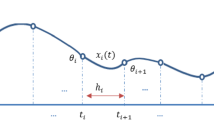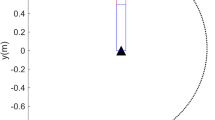Abstract
Time and jerk are two pivotal factors in the optimal trajectory planning of a manipulator. A trajectory that minimizes time and jerk can ensure smooth and efficient operation of the manipulator. This paper introduces a novel, general time–jerk optimization method for manipulators, which integrates quintic non-uniform rational B spline (QNURBS) with an improved dingo optimization algorithm based on simulated annealing, namely SA-DOA. This method has been successfully applied to plan the time–jerk optimal trajectory of the Kinova Jaco2 robot arm. With maximum angular velocity, acceleration, and jerk as constraints, and running time and total jerk as optimization objectives, the method employs SA-DOA to determine the optimal time interval and then utilizes QNURBS to generate the angle curves of the six joints in joint space, based on the specified path point and optimal time interval. Experimental results demonstrate that SA-DOA can obtain the global optimal solution within a limited number of iterations. Compared with dingo optimization algorithm (DOA), particle swarm optimization algorithm (PSO), and simulated annealing (SA), the optimization results have improved by 26.57%, 21.87%, and 0.26%, respectively. The time–jerk optimal motion trajectory enhances the execution efficiency of the manipulator and produces less jerk during movement, thereby improving motion control performance.






Similar content being viewed by others
References
Du ZJ, Liang YL, Yan ZY, Sun LL, Chen W (2021) Human-robot interaction control of a haptic master manipulator used in laparoscopic minimally invasive surgical robot system. Mech Mach Theory 156:104132
Angel SD, Ulises ZC, J Alfonso PG, Xiomara ZC (2019) Operation of a haptic interface for offline programming of welding robots by applying a spring-damper model. Int J Comput Integr Manuf 32(11):1098–1116
Barbosa WS, Gioia MM, Natividade VG, Wanderley RF, Chaves MR, Gouvea FC, Goncalves FM (2020) Industry 4.0: examples of the use of the robotic arm for digital manufacturing processes. Int J Interact Des Manuf 14:1569–1575. https://doi.org/10.1007/s12008-020-00714-4
Li X, Zhao H, He X, Ding H (2023) A novel cartesian trajectory planning method by using triple NURBS curves for industrial robots. Robot Comput-Integr Manuf 83:102576. https://doi.org/10.1016/j.rcim.2023.102576
Wang H, Heng W, Huang J, Zhao B, Quan L (2019) Smooth point-to-point trajectory planning for industrial robots with kinematical constraints based on high-order polynomial curve. Mech Mach Theory 139:284–293. https://doi.org/10.1016/j.mechmachtheory.2019.05.002
Dikra EH, Badreddine A, Larbi EB, Jalal EB (2019) Optimal trajectory planning for spherical robot using evolutionary algorithms. Procedia Manuf 32:960–968. https://doi.org/10.1016/j.promfg.2019.02.309
Lv Y, Peng Z, Qu C, Zhu D (2020) An adaptive trajectory planning algorithm for robotic belt grinding of blade leading and trailing edges based on material removal profile model. Robot Comput-Integr Manuf 66:101987. https://doi.org/10.1016/j.rcim.2020.101987
Miao X, Fu H, Song X (2022) Research on motion trajectory planning of the robotic arm of a robot. Artif Life Robot 27:561–567. https://doi.org/10.1007/s10015-022-00779-2
Ekrem Ö, Aksoy B (2023) Trajectory planning for a 6-axis robotic arm with particle swarm optimization algorithm. Eng Appl Artif Intell 122:106099. https://doi.org/10.1016/j.engappai.2023.106099
Fang Y, Qi J, Hu J, Wang W, Peng Y (2020) An approach for jerk-continuous trajectory generation of robotic manipulators with kinematical constraints. Mech Mach Theory 153:103957. https://doi.org/10.1016/j.mechmachtheory.2020.103957
Shrivastava A, Dalla VK (2023) A fast and unified method to find a minimum-jerk robot joint trajectory using particle swarm optimization. Arab J Sci Eng 48:2687–2699. https://doi.org/10.1007/s13369-022-07002-1
Wu H, Yang J, Huang S, Ning X, Zhang Z (2023) Multi-objective adaptive trajectory optimization for industrial robot based on acceleration continuity constraint. Robot Comput-Integr Manuf 84:102597. https://doi.org/10.1016/j.rcim.2023.102597
Huang J, Hu P, Wu K, Zeng M (2018) Optimal time-jerk trajectory planning for industrial robots. Mech Mach Theory 121:530–544. https://doi.org/10.1016/j.mechmachtheory.2017.11.006
Chen W, Wang H, Liu Z, Jiang K (2023) Time-energy-jerk optimal trajectory planning for high-speed parallel manipulator based on quantum-behaved particle swarm optimization algorithm and quintic B-spline. Eng Appl Artif Intell 126:107223. https://doi.org/10.1016/j.engappai.2023.107223
Karahan O, Karci H, Tangel A (2022) Optimal trajectory generation in joint space for 6r industrial serial robots using cuckoo search algorithm. Intel Serv Robot 15:627–648. https://doi.org/10.1007/s11370-022-00440-8
Zhang MS, Xiao JZ, Wang EH, Zhuang Q (2021) Inverse kinematical solving and trajectory planning of redundant manipulator. J Mech Transm 45(6):71–76
Zheng T, Liu ML (2020) A method of segmental interpolation trajectory planning for robotic arm. Mach Des Manuf 3:261–264. https://doi.org/10.19356/j.cnki.1001-3997.2020.03.063
Peiper DL (1968) The kinematics of manipulators under computer control. Phd Thesis, Stanford University
Liu C, Yang L, Zhang L (2021) Polynomial accelerated iterative approximation for higher order and rational Bézier curves. Results Math 76:138
Xie WS, Zhang S (2007) Generalized B-splines and knot insertion algorithm. J East China Univ Sci Technol 1:141–144. https://doi.org/10.14135/j.cnki.1006-3080.2007.01.032
Han J, Moraga C (1995) The influence of the sigmoid function parameters on the speed of backpropagation learning. In: Mira J, Sandoval F (eds) Paper presented at the From Natural to Artificial Neural Computation. IWANN 1995. Lecture Notes in Computer Science, vol 930. Springer, Berlin, Heidelberg
Hernán PV, Delgado AFP, Gustavo EC, Ana Beatriz MC, Jonás VA, Fernando RP (2021) A bio-inspired method for engineering design optimization inspired by dingoes hunting strategies. Math Probl Eng 2021:9107547
Kirkpatrick S, Gelatt CD Jr, Vecchi MP (1983) Optimization by simulated annealing. Science 220(4598):671–680
Funding
This work was supported by [Open Project of China International Science and Technology Cooperation Base on Intelligent Equipment Manufacturing in Special Service Environment](Grant numbers [ISTC2021KF07] and [ISTC2021KF08]), and by [China National Key Research and Development Project] (Grant number [2017YFE0113200]), and by [Anhui University of Technology youth Fund] (Grant number [QZ202217]).
Author information
Authors and Affiliations
Contributions
All authors contributed to the study conception and design. Material preparation, data collection and analysis were performed by [QP], [XX], [QL], and [HZ]. The first draft of the manuscript was written by [QP] and all authors commented on previous versions of the manuscript. All authors read and approved the final manuscript.
Corresponding author
Ethics declarations
Conflict of interest
The authors have no relevant financial or non-financial interests to disclose.
Additional information
Technical Editor: Adriano Almeida Gonçalves Siqueira.
Publisher's Note
Springer Nature remains neutral with regard to jurisdictional claims in published maps and institutional affiliations.
Rights and permissions
Springer Nature or its licensor (e.g. a society or other partner) holds exclusive rights to this article under a publishing agreement with the author(s) or other rightsholder(s); author self-archiving of the accepted manuscript version of this article is solely governed by the terms of such publishing agreement and applicable law.
About this article
Cite this article
Pu, Qc., Xu, Xr., Li, Qq. et al. Robotic arm time–jerk optimal trajectory based on improved dingo optimization. J Braz. Soc. Mech. Sci. Eng. 46, 198 (2024). https://doi.org/10.1007/s40430-024-04694-4
Received:
Accepted:
Published:
DOI: https://doi.org/10.1007/s40430-024-04694-4




